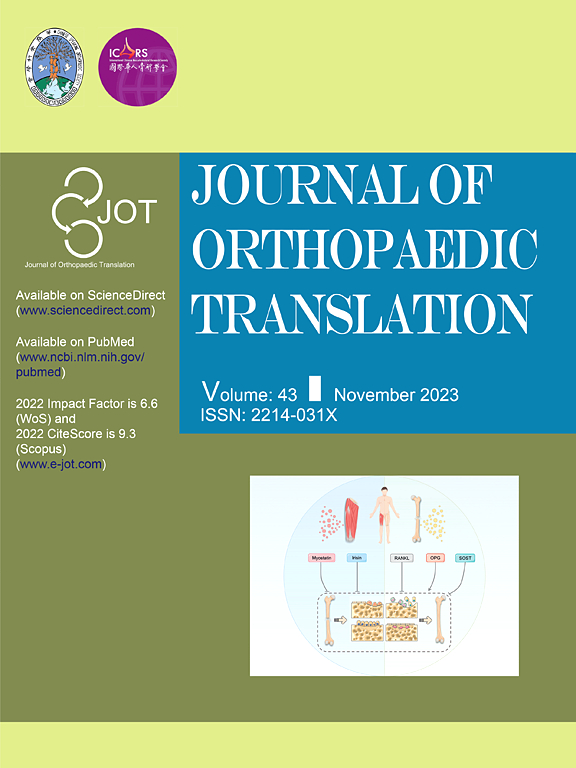Moldable self-setting and bioactive bone wax for bone hemostasis and defect repair
IF 5.9
1区 医学
Q1 ORTHOPEDICS
引用次数: 0
Abstract
Objective
Bone injury complicated with bleeding and irregular shaped defect are challenging in orthopedic surgery and practices due to the lack of reliable hemostasis and simultaneous defect repair strategy. Bone wax is a century-old biomaterial for bleeding management in orthopedic surgery, characterized with ready-to-use advantage but the risk of failed bone reunion due to the biological inertness and non-degradability. In current work, integration of bioceramic cement and premixed concept was motivated to prepare a in situ self-setting bioactive calcium phosphate based bone wax (CaPBW) for bone hemostasis and defect repair.
Methods
A moldable, in situ self-setting bioactive CaPBW with a novel formulation of calcium phosphate cement (CPC), monetite (DPCA) granules, modified starch and polyethylene glycol (PEG) was developed for bone hemostasis and defect repair. The CaPBW material was evaluated by characterization, physical and chemical properties, biocompatibility, osteogenic ability and hemostatic ability.
Results
CaPBW adopted the ready-to-use feature of traditional bone wax, showing feasibility in shape molding and defect sealing. When interacted with physiological fluid like blood, CaPBW could transformed from putty to solid state within tens of minutes due to the gradual PEG-water exchange and CPC hydration, providing mechanical stability for bleeding clotting and bone defect filling. In vitro studies revealed the superiority of CaPBW over bone wax in blood coagulation and osteoblast differentiation, along with hemocompatibility and osteogenesis confirmation. In vivo studies demonstrated the reliability of CaPBW in hemostasis and bone regeneration compared to traditional bone wax, promoting the efficacy of bone bleeding and new bone formation.
Conclusion
As compared to traditional bone hemostatic agent bone wax, CaPBW not only preserved its advantages in handling and defect sealing, but also provided platform for temporary physical support and bone regeneration acceleration.
The translational potential of this article
The integrated design of osteogenesis and hemostasis makes CaPBW have the dual functions as bone hemostasis material and artificial bone substitute. CaPBW therefore demonstrates a strategy of next-generation bone wax with high translational potential for orthopedic surgery.

用于骨止血和骨缺损修复的可塑自固性生物活性骨蜡。
目的:骨损伤合并出血及不规则骨缺损,由于缺乏可靠的止血和同步修复策略,一直是骨科手术和实践中面临的挑战。骨蜡是一种具有百年历史的骨科出血处理生物材料,具有即用性优势,但由于其生物惰性和不可降解性,存在骨愈合失败的风险。本研究旨在将生物陶瓷水泥与预混概念相结合,制备一种原位自固化生物活性磷酸钙骨蜡(CaPBW),用于骨止血和骨缺损修复。方法:采用磷酸钙水泥(CPC)、铁云母(DPCA)颗粒、改性淀粉和聚乙二醇(PEG)组成的新型配方,制备一种可塑的、原位自固化的生物活性CaPBW,用于骨止血和骨缺损修复。通过表征、理化性能、生物相容性、成骨能力和止血能力等指标对制备的CaPBW材料进行评价。结果:CaPBW采用了传统骨蜡的即用特性,在形状成型和缺陷密封方面具有可行性。当CaPBW与血液等生理液体相互作用时,由于PEG-water的逐渐交换和CPC水化作用,可在数十分钟内由腻子转变为固体,为凝血和骨缺损填充提供了机械稳定性。体外研究表明,CaPBW在凝血和成骨细胞分化方面优于骨蜡,并证实了血液相容性和成骨作用。体内研究表明,与传统的骨蜡相比,CaPBW在止血和骨再生方面具有可靠性,可促进骨出血和新骨形成的疗效。结论:与传统骨止血剂骨蜡相比,CaPBW不仅保留了其处理和缺损密封的优势,而且为临时物理支撑和骨再生加速提供了平台。本文的转化潜力:成骨止血一体化设计,使CaPBW具有骨止血材料和人工骨替代品的双重功能。因此,CaPBW证明了下一代骨蜡在骨科手术中具有很高的转化潜力。
本文章由计算机程序翻译,如有差异,请以英文原文为准。
求助全文
约1分钟内获得全文
求助全文
来源期刊

Journal of Orthopaedic Translation
Medicine-Orthopedics and Sports Medicine
CiteScore
11.80
自引率
13.60%
发文量
91
审稿时长
29 days
期刊介绍:
The Journal of Orthopaedic Translation (JOT) is the official peer-reviewed, open access journal of the Chinese Speaking Orthopaedic Society (CSOS) and the International Chinese Musculoskeletal Research Society (ICMRS). It is published quarterly, in January, April, July and October, by Elsevier.
 求助内容:
求助内容: 应助结果提醒方式:
应助结果提醒方式:


